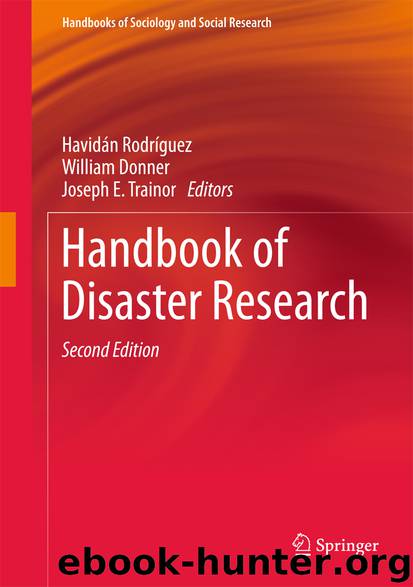Handbook of Disaster Research by Havidán Rodríguez William Donner & Joseph E. Trainor

Author:Havidán Rodríguez, William Donner & Joseph E. Trainor
Language: eng
Format: epub
Publisher: Springer International Publishing, Cham
15.6 The Growth of Geographic Informations Systems (GIS) in the Field
GIS applications have made strong headway into the field since the late 1980s/early 1990s in both an academic and practitioner context due to the introduction of more powerful computing (Thomas, Ertugay, & Kemec, 2007), but, according to scholars, have only seen major use in the analysis of disasters since roughly the late 2000s. Indeed, Cappock (1995) reports that, as of 1995, the connection between GIS and disasters had been “scarce” (see Dash, 1997). As a methodological tool, GIS offers researchers and practitioners a wide range of options in the collection, organization, building, visualizing, and analyzing of datasets, as well as the prediction and projection of data trends. The use of GIS as a research tool falls into three categories: a) as a method of presenting findings, b) as a method of building datasets, and c) as a planning tool that links research and strategic decision making. Borden and Cutter (2008) mapped spatial distributions of mortality outcomes for natural hazards. Other scholars have used GIS to present the geographic distributions of vulnerable populations in the United States and Puerto Rico (Cutter, Boruff, & Shirley, 2003; Peacock, Van Zandt, Henry, Grover, & Highfield, 2012).
One key strength of GIS is that it offers links between research and practice. GIS provides significant tools for planning, mitigation, and response by translating complex research ideas into visualized formats. In a recent study, Kyne (2015) examined the estimated and predicted plume path of nuclear fallout in relation to major population concentrations (see Fig. 15.1). Kyne’s work links research and empirical observations and condenses them into an easily digestible format for those charged with planning and preparing for disaster. GIS may also be used to build data sets, as well. Donner (2007) used GIS to geolocate tornado touchdowns via latitudinal and longitudinal coordinates in order to examine the relationships between sociodemographic characteristics, tornado intensity, and mortality outcomes.
Fig. 15.1Projected plume path from core-damage accident. Here the predicted concentration and direction of radioactive smoke plumes are overlaid on county maps with demographic information
Download
This site does not store any files on its server. We only index and link to content provided by other sites. Please contact the content providers to delete copyright contents if any and email us, we'll remove relevant links or contents immediately.
The Secret History by Donna Tartt(18849)
The Social Justice Warrior Handbook by Lisa De Pasquale(12142)
Thirteen Reasons Why by Jay Asher(8796)
This Is How You Lose Her by Junot Diaz(6794)
Weapons of Math Destruction by Cathy O'Neil(6146)
Zero to One by Peter Thiel(5686)
Beartown by Fredrik Backman(5599)
The Myth of the Strong Leader by Archie Brown(5425)
The Fire Next Time by James Baldwin(5249)
How Democracies Die by Steven Levitsky & Daniel Ziblatt(5128)
Promise Me, Dad by Joe Biden(5087)
Stone's Rules by Roger Stone(5026)
A Higher Loyalty: Truth, Lies, and Leadership by James Comey(4845)
100 Deadly Skills by Clint Emerson(4840)
Rise and Kill First by Ronen Bergman(4704)
Secrecy World by Jake Bernstein(4646)
The David Icke Guide to the Global Conspiracy (and how to end it) by David Icke(4625)
The Farm by Tom Rob Smith(4438)
The Doomsday Machine by Daniel Ellsberg(4416)
